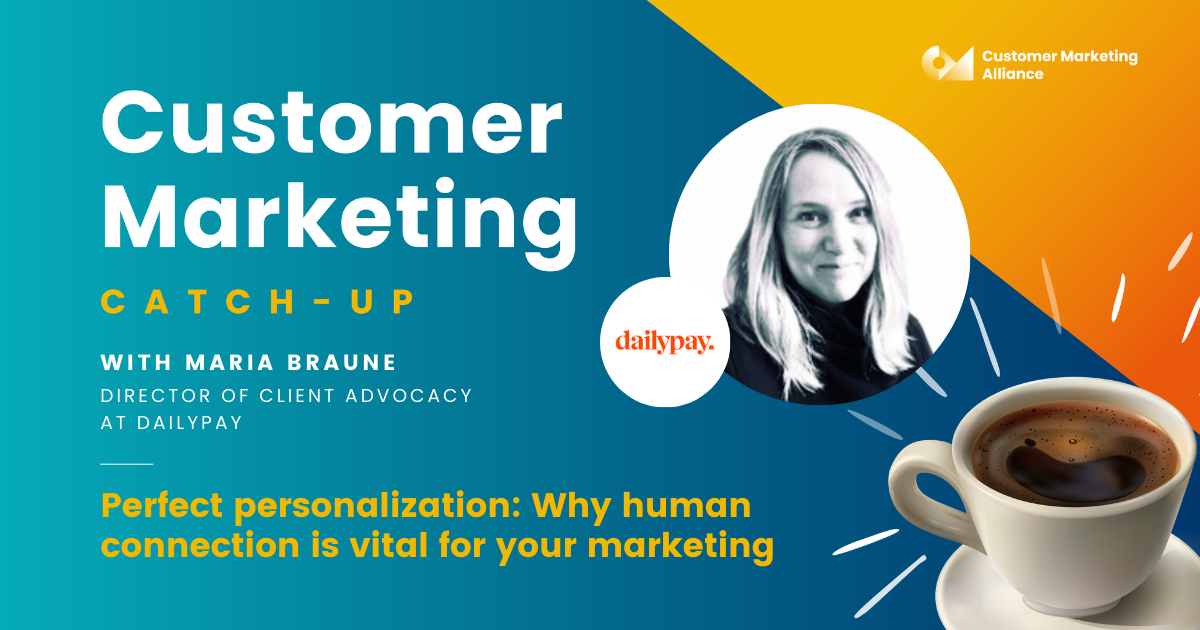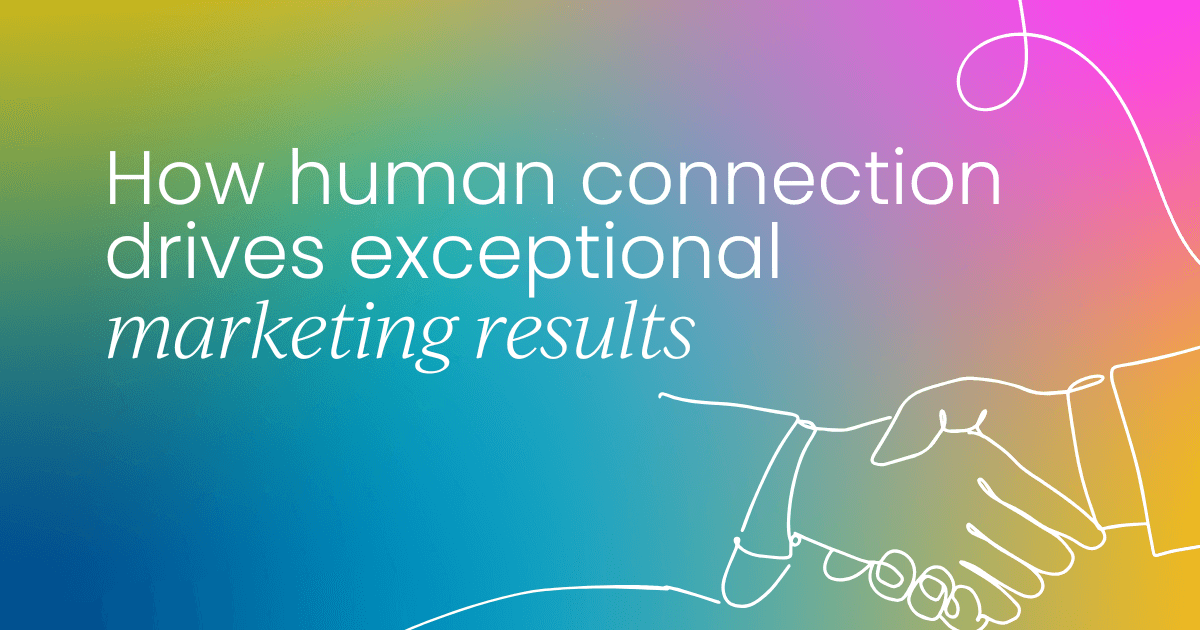As marketing becomes more saturated and customer attention harder to earn, personalization is no longer a “nice to have”: it’s the foundation for building trust, loyalty, and long-term value.
At DailyPay, we’ve learned that effective personalization isn’t just about using someone’s name in an email – it’s about understanding who they are, what they need, and where they are in their journey.
In this article, I’ll walk through the key principles that have shaped my approach to customer advocacy and personalization – from starting small and scaling with data, to re-engaging at-risk accounts, and creating surprise-and-delight moments that truly resonate.
These are the strategies that have helped us build stronger relationships, even in moments of uncertainty, and they all start with putting the human connection first.
Why personalization matters more than “Dear [First Name]”
Personalization isn't just about inserting a name into an email. It starts with data – knowing what you have and what you can actually act on.
Before building out any kind of personalized experience, you have to understand what that personalization should be based on. For me, it's about seeing the ebb and flow of how people move in and out of different personas.
People evolve, their needs shift, and if we treat them like they fit permanently into one static segment, we’re missing the mark.
Personalization works best when it’s fluid. Whether it’s someone moving through a buying journey or discovering new use cases for a product, it’s our job to tailor experiences to where they are, not just where we think they should be.
That’s where the power lies: in making people feel like you truly understand them. And when that happens, they gravitate toward your brand more naturally.
Earlier in my career, I saw this firsthand in the email marketing world. We looked deeply at behavioral trends and served content accordingly, often before the user even realized they wanted it. That’s where the magic happens. It feels like serendipity to the user, but it’s all rooted in smart strategy. And when you do it right, you build trust.
That’s the real outcome: personalization creates trust.

Creating connections in a world of competing priorities
One thing that’s important to remember is that while you might feel like you're the only one trying to reach a customer, you’re not. In B2B, especially, a single contact at a company might be juggling multiple CSMs, tools, marketing messages, and beta invitations – just from one vendor. Multiply that by their full tech stack, and it’s overwhelming.
So if you’re reaching out without personalization – without context – you’re probably getting ignored. I always encourage people to think about what makes a real relationship work. Sometimes, you don’t talk every day. But then out of the blue, you get a note from someone saying, “Hey, I saw this and thought of you.” That kind of message cuts through the noise. No ask.
No pitch. Just a connection.
That’s the spirit behind what I used to call "drive-by emails" – quick check-ins that say, “Hey, you came to mind.” Not only are they low-pressure, they’re powerful reminders that there’s a real person on the other side of the screen.
Scaling personalization with purpose
To truly scale personalization, you can’t just rely on instinct or manual outreach. You have to put in the work upfront. That means building data-driven cohorts, defining fluid personas, and constantly checking in to make sure the experiences you're offering still resonate.
We do this in our own programs by tailoring journeys based on where a customer is in their lifecycle – are they in the onboarding phase? Exploring new features? Expanding into new business units? Each of those paths requires a different approach.
And it's never one-size-fits-all. It’s built from a matrix of behavioral signals and touchpoints, and it should evolve with the customer.
People grow, products change, industries shift. So your personalization strategy has to keep up. I like to think of it like gentle nudges, guiding someone from one phase to the next without them even realizing they’re being led. It’s subtle, intentional, and grounded in a deep understanding of where they are – and where you want them to go.
Start small and stay human
It’s easy to get overwhelmed by data. Sometimes we get so deep into the metrics that we forget the human on the other end. That’s when personalization starts to feel mechanical, and people can sense that. The key is to begin with a few meaningful data points. What behaviors or patterns stand out? What content truly resonates?
Start there. Build out personas based on those insights, but don’t treat them as fixed. Personas should be a starting point, not a box to lock someone into forever. Think about how to help that person evolve – from a new user to a champion, from curious to confident.
And always remember: the end goal of personalization isn’t the message. It’s the movement. You’re guiding people forward, not just making them feel seen,but helping them grow with you.
Where to begin with personalization
If you’re stepping into personalization for the first time, especially as a new customer marketer, my biggest advice is to stay humble and be willing to test everything.
You’re going to have big ideas – your dream content, messaging, and journey flows – but some of them won’t land. And that’s okay. You have to figure out where the friction points are. Where are people dropping off? Are you overwhelming them? Are you hitting them with too much, too soon?
Start with a single, simple journey – one or two moments that you’re already executing – and tweak just those. Watch what happens. Did engagement increase? Did users take the action you wanted them to? Then move to the next piece. Personalization doesn’t have to be overwhelming – it’s a series of informed experiments.
I like to think of it as a hit list. Look at different stages of the customer journey and ask: “Where are we seeing drop-off? Where is engagement stale?” For example, if you’ve identified a “steady state” 13 weeks into the journey, think about how you might rejuvenate the experience there. Don’t try to personalize everything at once – start small and build momentum from what works.
Why piloting personalization matters
One of the smartest ways to introduce personalization is by framing it as a pilot. That word changes everything. It softens resistance, builds buy-in, and signals that this is an experiment, not a mandate. You’re not overhauling the entire customer experience; you’re testing a variation with a small cohort to see what impact it has.
And here’s a pro tip: don’t start testing in high-stakes moments like upsell or expansion phases. Start earlier in the journey – during onboarding or early adoption. That’s where you have more room to adjust and refine. If you lose someone in those early moments, you still have time to rebuild trust. But if you lose someone during an upsell attempt, you may not get another shot.
Personalization as an excuse to clean house
Piloting also gives you the perfect opportunity to do some internal housekeeping. It’s a great excuse to take inventory of what you’re sending out and ask: what’s still useful? What’s just noise?
I’ve had moments where I’ve gone to marketing ops and said, “Hey, we can probably trim some of this fat,” and they’re thrilled – because no one wants to be sending irrelevant content.
At the same time, you’ll likely need to introduce some new messaging or functionality, which might mean tapping your dev team, your copywriters, or your designers. That’s where your approach matters. Lead with how you’re going to make things better, and build trust by keeping teams in the loop.
It’s not about getting approval on every word or button. It’s about alignment. Does the team believe in the concept? Do they understand the “why” behind the change? Once you have that buy-in, you can keep them updated with results. Share what worked – was it a subject line? A repositioned call to action? – so they feel part of the journey without needing to control it.
The power of cross-functional buy-in
One of the biggest lessons I’ve learned is that cross-functional collaboration can make or break your personalization efforts. It’s not just about launching a program – it’s about bringing your internal stakeholders along for the ride. And that means setting expectations early, communicating transparently, and showing empathy for how busy everyone is.
We’re all juggling so much, and change, especially unexpected change, can feel like a threat. When people aren’t looped in, their instinct is to resist. Not because they’re against you, but because they’re already stretched thin and relying on muscle memory to get through the day.
Personalization isn’t just about connecting with customers. It’s also about connecting internally – with legal, sales, product, ops, and more. I like to think of our role as kind of like being B2B sports agents.
We don’t just highlight customer stories – we elevate our colleagues, our teams, and our shared goals. That kind of internal relationship-building is just as important as any personalization journey you put in front of a customer.
Why personalization fuels sustainable growth
One of the most overlooked moments in a customer’s lifecycle is what happens after the initial excitement wears off – when the deal is signed, the platform is integrated, and the shiny new toy isn’t quite so shiny anymore.
During acquisition, there’s typically a lot of attention: a salesperson is actively engaged, there's dedicated onboarding support, and it all feels personal. But once the customer hits that "steady state," that level of intimacy drops off – and that’s when personalization becomes not just important, but essential.
In the growth stage, your customers are juggling multiple priorities, tools, and stakeholders. They’re being pulled in every direction. That’s exactly why your efforts need to cut through the noise. You can’t assume that just because a customer signed a contract, they’re fully bought in for the long haul. Engagement fluctuates. Usage dips. And if you're not paying attention to those early signs of disengagement, you risk churn.
This is where data becomes your best friend. Are they logging in? What features are they using? Where are they dropping off? And most importantly, are they seeing success? That’s the moment to lean in with personalized messaging – something that speaks directly to what they’re experiencing right now.
And here's where advocacy becomes a powerful lever. Even if a customer’s usage is down, they may still be ideal candidates for things like webinars, blogs, or speaking opportunities.
By inviting them to participate in these programs, you can re-engage them in a way that feels meaningful and personal. Sometimes just being asked to co-host a session or share a story is enough to spark a renewed interest in your platform.
It’s not just about retention – it’s about deepening their connection to your brand. That’s the real power of personalization.
Building anti-fragile programs through personalization
Personalization isn’t just a strategy for engagement – it’s a foundation for resilience. Especially in today’s climate, when acquisition is harder and resources are tighter, personalization helps you get more out of your existing customer base.
You’re not starting from scratch. You’re not chasing net-new leads. You’re working with people who already said “yes.”
This approach is what I call anti-fragile. It holds strong in both abundance and scarcity. It works whether you're in a growth phase or a more cautious, constrained environment. That’s why customer marketers are being asked to do more with less right now – to increase value from the install base without burning through budget or people.
But for this to work, we have to do more than just talk about value. We have to show it. And that means personalizing not just our customer communications, but our internal ones, too.
If you want to elevate personalization within your company, you need to speak the language of each department. Show legal how it reduces risk. Show sales how it supports renewals. Show product how it surfaces real user feedback.
And when you go to execs, frame it in terms of overall business value and retention impact. It’s not a one-size-fits-all message internally, either. Just like with customers, it takes empathy, insight, and strategic storytelling.
Personalization doesn’t just connect people to your brand – it connects your teams to a shared vision. And in today’s world, that alignment is everything.
Personalization isn’t a cure for churn: But it can be a powerful deterrent
Let’s be real: personalization won’t magically eliminate churn. I’ve seen customers leave even when everything on paper looked perfect – high adoption, great engagement, strong relationships.
But churn can happen for reasons completely out of your control. A CEO chats with a competitor over dinner. A board makes a top-down decision to switch vendors. Sometimes you're just caught in a political game that has nothing to do with your service.
That said, what personalization can do is build trust over time, and trust creates hesitation when someone starts to consider alternatives. If you’ve done your job building a personalized, relationship-first experience, your customers know you get them.
They see the effort, the thoughtfulness in your communication and the relevance of your content. And when a competing vendor comes in with generic messaging, that contrast is glaring.
It’s not about preventing churn at all costs – it’s about being the kind of partner they’re reluctant to leave. A customer might say, “Maria really understands me. Her team has always treated me like a person, not just a contract.” That emotional loyalty matters. It might not stop churn every time, but it definitely slows it down. It buys you time. It gives you a fighting chance.
Building advocacy during risk moments
One of the most underrated strategies is looping in advocacy during churn-risk moments. Even if a customer’s platform engagement is slipping, they might still be open to things like events, panels, or co-hosting opportunities. And those invitations do more than just promote your brand – they remind customers of your value in a way that feels human.
Sometimes the invitation alone reignites interest. It gets them thinking: “Wait, are we still using that platform the way we used to? Should we be doing more with it?” And suddenly, you’ve created a bridge – one that a CSM can walk across to re-engage that customer more meaningfully.
I’ve seen customers who looked “cold” in the data light up again because they were invited to speak at a roundtable or share their story. That outreach made them feel seen, valued – and that made all the difference.
When things go wrong, own it with empathy
There are times when you will drop the ball. It happens. Software evolves quickly, customer needs change, and sometimes we just miss the mark. And when that happens, it’s on us to rebuild trust. Not with excuses. Not with polished talking points. With honesty and empathy.
We’ve all seen it – the customer who stuck their neck out internally to champion your product. They convinced their boss. They got budget. They pushed through change management. And now it’s not working. They’re frustrated and maybe even embarrassed. That’s a human moment – and we need to show up for it as humans.
This is where re-engagement programs can really shine. It’s not just about getting them to use your product more. It’s about restoring their confidence, helping them feel like a rock star again in front of their team. We should be asking: “How can I make this person look amazing at their next meeting?” That’s the mindset.
Listening without fear
One of the most powerful things we’ve done recently is invite customers to join our Client Advisory Board – even the ones with low adoption. Some people questioned that move: “Why are they on the list? Their usage is down.” But that’s exactly why I wanted them there.
I wanted to hear directly from them: What’s not working? Why haven’t we delivered the impact we promised? And I wanted them in a room with high-engagement customers, so we could all learn together.
Sometimes that means hearing hard truths over cocktails and dinner. But that’s how you grow. That’s how you spot potential red flags early and keep small problems from becoming systemic issues.
Avoiding difficult conversations doesn’t make churn go away. But inviting those conversations? That’s how you protect your reputation and strengthen relationships – even if a customer does end up leaving. At the very least, they’ll remember that you listened.
It's better they vent to you than to their boss
This is one of my core philosophies: it’s always better for a frustrated customer to vent to you than to their boss. You want them to feel comfortable saying, “Here’s what’s not working.” And when they do, your job is to stop, listen, and say, “Yeah, you’re right. That would be frustrating.”
Sometimes, you can fix it. Sometimes you can’t. But acknowledging the issue and showing that you care goes a long way. These moments matter. They’re where customer loyalty is either reinforced or eroded.
How personalization sustained us through crisis
If I think back to how personalization helped us through tough global moments like COVID or today’s economic challenges, it really comes down to this: it saves people time.
And in moments of uncertainty, time becomes even more valuable. I remember those early Amazon days when they’d show me, “Here’s what you should read next,” and I’d think, thank you for thinking for me. You’ve saved me from falling down a rabbit hole of indecision.
That’s what great personalization does. It gives people clarity. It says, “You’re here. This is your next best step.” And when we as marketers do that well, it doesn’t just feel helpful – it builds trust.
During COVID, and even now as we navigate budget freezes and economic shifts, we leaned into that mindset. We delivered short, snackable content – things like quick videos, quotes, and case studies. Nothing overwhelming. Just small, perfectly-timed nudges. The kind of content that made customers think, “Oh, that’s what we should try next,” without them realizing we were gently guiding them forward.
It’s all about timing, which starts with data. If someone’s been in the platform for a while, we know what they’ve done – and what they haven’t. That insight lets us tailor the right piece of content to the right moment. Not to overwhelm them, but to spark that internal momentum again. To say, “You’ve done this, now here’s what’s next.”
That’s the goal. Not just to personalize for the sake of it, but to help people grow without even realizing they’re being led.
The personal touch that sticks
Personalization can be strategic, but it can also be joyful. One of the best applications I’ve seen came from a “surprise and delight” program. It reminded me that personalization doesn’t always have to be tied to product usage or metrics – it can simply be about making someone feel seen.
We created a set of moments – life milestones like having a baby, getting married, or just celebrating a favorite sports win. CSMs could “spend” a few of these moments each quarter on customers they felt deserved something special. And it wasn’t just about sending a gift – it was about creating a story around it.
The CSM would record a quick message, and we’d sometimes even loop in the customer’s boss to share a congratulatory video. That gift? It landed differently. It wasn’t transactional. It was layered with meaning. It said, “We see you. We care. You matter to us.”
That’s the kind of personalization that sticks. Not because it’s flashy, but because it’s thoughtful. And in a world where everyone is moving fast and being pulled in a million directions, thoughtful wins every time.
Final thoughts
If I had to sum up personalization in one idea, it’s this: grow your customers without them knowing you’re growing them. Guide them gently. Build trust. Time things right. And always, always come from a place of understanding.
It’s not about flashy tech or fancy segmentation. It’s about being the Amazon recommendation that shows up right when someone needs it – quietly, helpfully, without making a big fuss.
That’s where the magic of personalization really lives.
This article was derived from Maria's appearance on the Customer Marketing Catch-up podcast.


 14 min read
14 min read
 Follow us on LinkedIn
Follow us on LinkedIn




